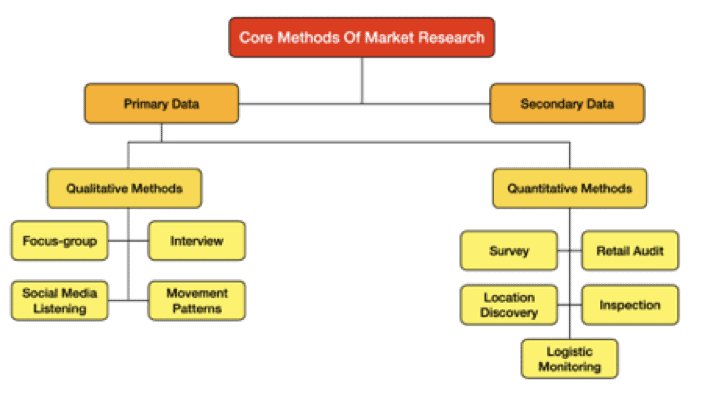Once you’ve chosen to conduct primary research, you might be wondering what’s next, and in this blog post, we will cover how to select the best method for your market research needs. Correctly choosing your research methodology is highly essential for your company, since it clarifies the purpose and goals of the project for both the researcher and the client. Below are some of the most popular methodologies used for market research.

Defining Research Goals and Potential Methods
Defining your goals is the first step you should take in determining the specific method for your research project. There are two primary buckets that research methods fall into: qualitative and quantitative. Your research questions and your preferences are what determines which is the best option. In many cases, the ideal primary research strategy would be a mixed methods approach involving both qualitative and quantitative methods.
Suppose the research goal is to deepen your knowledge, to get more specific information about a product, to explore ideas, meanings and thoughts, or to understand your audience honestly. In that case, the following qualitative methods may be the most suitable for your needs:
- Focus groups are best if the research participants are a “typical” representation of your target audience. Focus groups can be homogeneous or heterogeneous. Consider using this method when you need new ideas, want to evaluate new products or packaging, develop advertising strategies, or obtain preliminary information on a product.
- Interviews allow for a semi-structured format that enables the respondent to give detailed answers to the questions asked. Use this method when the research topic is potentially too personal or sensitive for a group setting, when you would like to gather deeper insights from a respondent, or when it is impossible to gather all respondents together.
- Movement patterns are a method of investigation when you want to understand or explain the location patterns of consumers. It is preferable when it is vital to get a geospatial understanding since it provides a complete view of the flow of people and more comprehensively recognizes consumer behavior in a specific area.
- Social media listening is a newer method that is very useful for collecting information and deriving insights from the consumers in their digital environments. This method can help you understand what customers are saying about your organization, competitors or specific topics.
The second methodological approach is quantitative. It is used to measure, test or confirm something in the research question, and the following methods are some ways to collect quantitative data:
- Surveys can investigate consumers’ opinions on a range of issues through either an in-person or a digital questionnaire. Surveys differ from other qualitative methods because it can be applies at a larger scale that allows for statistical inference of the whole population. When you need to understand an audience, gather targeted results, answer specific questions, or measure particular features, a survey is suitable.
- Retail audit analyzes the health and overall state of a brand’s products or services at targeted retail outlets. Select this method if you want to define the market volume or the market share or to conduct a comparative analysis of various products and various market participants.
- Location discovery is suitable if your product or service depends on the accurate information of its location and the research goals require its measurement.
- Logistic Monitoring is the method used for gathering real-time ground-level information on the supply chain. Choose this method if you need to have verified information about product offerings or delivery.
While the different research methods in this blog are split between qualitative and quantitative, many of them are used for both, depending on how the data is collected and analyzed.
Practical Considerations
The last step to check whether the specific method was right is to reflect on the practical considerations, which are almost as important as the goal. The physical features such as time, resources, financial opportunities, data availability and access to respondents may initially seem less critical. However, they could ultimately result in extensive alterations to the whole research project. Be sure to address these questions before the initial start of the research study.
Conclusion
Although it may seem that the goal of the research is the primary reason to choose the method, it is highly essential to consider both practical considerations and the intention of the research, since only in duet they will provide benefits for the companies and the research itself.
First, set the goal; second, choose the method; and third, check the availability of the required resources. Keep in mind that you can outsource this work to other companies, like Premise, who can help you choose the most appropriate method and execute the project on your behalf.
Learn more about how Premise can help you to fulfill your market research needs by checking out our business solutions or email [email protected].